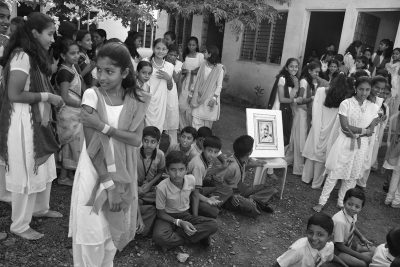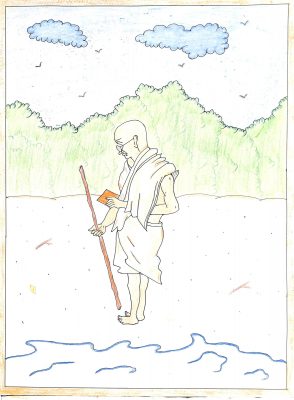
The Child in the Making of the Father of the nation
This project underscores the importance of the child in the making of the father
of the nation. Of the several titles conferred upon him, the one that Mohandas
Karamchand Gandhi embraced wholeheartedly was bapu, “father.” In the
early years of the 20th century, he came to be widely referred to as such, as he
increasingly took up the cause of his fellow Indians against a racist colonial
state in South
Africa. By his own admission, Gandhi felt he had failed as a father of his
own four sons, and was even quite ambivalent about fatherhood, preferring at
times to see himself as “mother.” Increasingly though, after 1915, he referred
to himself as Bapu when he signed off on routine letters to family, followers,
and friends: the phrase “Blessings from Bapu” recurs across his voluminous
correspondence, even when he wrote to adult men and women.
Who then was a child in the eyes of Bapu? As is typical of Gandhi, in this
regard as well, there was some inconsistency. At a very fundamental level,
anyone younger than 16 years of age was a child in his eyes. “According to our
shastras [traditional precepts], a child should be lovingly reared for five
years, should be disciplined for ten years—‘disciplined’ not with physical
punishment but with instruction and persuasion—and a son of sixteen should be
regarded as a friend.” All the same, every now and then, Gandhi also suggested
that one crossed “the age of innocence” at age 12, and responsibilities began to
mount after. By 1937 when he began to promote what came to be called nayee
taleem or new education, schools opened under its aegis typically were
limited to those under 14. However, Gandhi also used words like “child,”
“children,” “boy,” and “girl” (and their equivalents in Gujarati and Hindi)
capaciously, especially as he himself got older, to refer to close and intimate
adult followers. Even those who were not Indian were frequently referred to as
such, a case in point being his Danish devotee Esther Faering Menon, letters to
whom invariably began, “My dear child.” At this level, because he was deemed
father of the nation, all citizens of India were by definition his children.
Such a broad usage was also in keeping with his sense that all human beings are
children in the eyes of the deity. He may have been Bapu to millions, but he
himself was also a child, not just of God but of Mother India:
I cling to India like a child to its mother’s breast, because I feel that
she gives me the spiritual nourishment I need. She has the environment that
responds to my highest aspirations. When that faith is gone, I shall feel like
an orphan without hope of ever finding a guardian.
This project is specifically focused however on children—and child artists—who
are less than 16 years of age and what they made of their Bapu, and what he
thought about them. To a large extent, the Mahatma’s evolving views on children
were generic: he considered them “pure” and “innocent,” and a “joy” to be
around. As did so many others, he saw the future of India in its children and
youth. Like many an adult, he also found them less complicated and easier to
bend to his will.
At the same time, more so than other male leaders of his time, Gandhi spent a
lot of time thinking about and addressing issues specific to childhood from
toilet training to budding sexuality, writing extensively to children and
speaking to them, spending hours in their company, and openly professing the
importance of learning from them, his letters and speeches replete with specific
examples and instances of such lessons. His residences were filled with children of kin and
followers alike. Several of his political-ethical projects—be they the awakening
to racial justice in South Africa, or the use of fasting as a practice of
persuasion—were on account of children. His speeches and writings frequently
invoked children of Hindu mythology and literature such as Prahlad and Shravan
as exemplars for the adults of his generation. Virtues he associated with
children—their simplicity, candor, even sense of mischief and play—were held out
to adults to imitate. “We have all to aspire after being childlike. We cannot
become children, because that is impossible. But we can all become like
children.” When he was around children, as many a contemporary noticed, he
became like a child himself, readily and willingly taking on their persona.
On the other hand, and sometimes in the same breath, he would scold adult
followers for being childish, or for behaving like children. While he held
children out as exemplary, he still sought to transform them into the ideal
child of his vision. In a moment of extreme thought—to which he was not
infrequently prone—he even declared that if it was left to him, there would be
no children brought into this world.
Over the decades, India’s children have been bombarded with books about their Bapu, including some beautifully illustrated by well-known artists. Yet few who have really explored what Gandhi said, wrote, and thought about the child, and even fewer have asked what the child made of him, whether in words or images. This project takes on these matters in order to emphasize the child’s constitutive place in the making of the man we hail as Mahatma.
Select References
M.K. Gandhi, India of My Dreams. Edited by R.K. Prabhu. Bombay: Hind Kitab, 1947, 13.
Collected Works of Mahatma Gandhi
9: 205; 18: 329; 55: 209; 61: 394.M.K. Gandhi, India of My Dreams. Edited by R.K. Prabhu. Bombay: Hind Kitab, 1947, 13.



